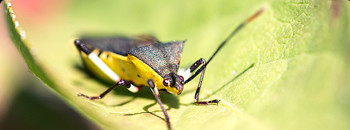My children never cease to amaze me, and I know most of you parents out there can relate. Recently the curiosity of my 4-year-old twin girls had me doing a double take … literally! They taught themselves to spot mosquito larvae.
Now, you may be thinking, ‘That sounds interesting…’ but hear me out.

I’m a mother of four and an entomologist. Needless to say my kids have seen their fair share of my research or, as they like to call it, my “science experiments.” Right now I’m doing a lot of work around mosquito-borne illnesses, and it just so happens I live outside of Dallas, Texas, where we’ve experienced torrential rains in the past couple of months. An overabundance of rain means a lot of standing water – the perfect breeding ground for mosquitoes. So, I headed into my own backyard and collected a couple of buckets showing signs of mosquito breeding for research sampling.
By the time I was ready to take my collections to the office, my girls had studied them long enough to know what mosquito larvae look like. Off they went, trudging through the backyard to see if they could spot – and dump – any others.
Their excitement and curiosity was adorable, and it got me thinking – if we don’t know what we’re looking for we can’t prevent it. This is particularly true when it comes to mosquitoes.
Part of my job as an entomologist for Texas A&M AgriLife Extension is to educate the people on things that are important to human and animal health – mosquitoes included. And as a mom, keeping my kiddos safe is at the heart of everything I do. With that in mind, I pulled together a list of things you should know about protecting your family from mosquito-borne illnesses.
- Mosquito-specific repellent works. Did you know the safe use of mosquito repellent is one of the single most effective options for protecting yourself and your family from mosquito bites? Check out the Centers for Disease Control and Prevention’s (CDC) guidelines for EPA-approved mosquito-specific repellent. The research to support the CDC’s recommendations is both exhaustive and scientifically proven. Trust me when I say I would never use products on my children that weren’t proven safe and effective. (Side note: As an expert (and a mom), I also steer clear of using the 2-1 products such as sunscreens that also contain repellent or other products. Buy sunscreen and insect repellent separately, since they should be reapplied in different intervals of time).
- Take action. We can do our part to protect our families and our communities. Eliminate standing water, wear light-colored clothing, and learn how to use repellents by reading the labels. Some should be applied often or in certain environments, such as swimming, sweating or being exposed to the sun for long periods of time. RISE (Responsible Industry for a Sound Environment) provides more tips here.
- Know your risk. There are many species of mosquitoes – and not all of them bite humans. Learning a little about the characteristics of mosquitoes can go a long way in preventing bites. For example, the mosquito species carrying the Zika virus likes light. It’s a daytime biter, but can also bite at night in a brightly lit environment, such a soccer fields or baseball stadiums. Mosquitoes carrying West Nile Virus are nighttime biters.
Much of the fear we feel about mosquito-borne diseases comes from what we don’t know. I hope the curiosity of two 4-year-old girls in Texas inspires you and your family to learn together – and have fun doing it!

